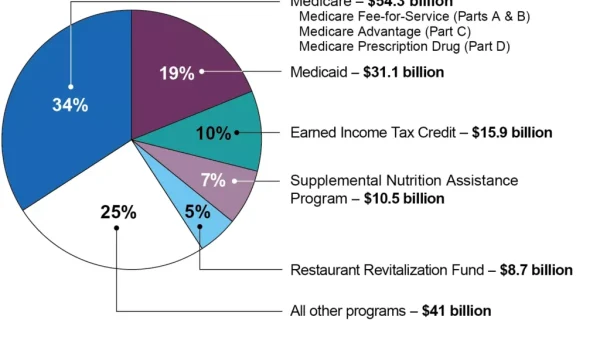The latest employment data from the Bureau of Labor Statistics for June 2024 offers a compelling snapshot of the divergent economic fortunes of red and blue states. The national unemployment rate remained steady at 4.1 percent, a modest increase of 0.5 percentage points from June 2023. Yet, beneath these headline figures lie significant contrasts between states, particularly economically vibrant red and struggling blue states, with Texas and California as prime examples.
Texas: A Beacon of Prosperity
Texas continues to exemplify the benefits of more free-market policies, evidenced by its impressive employment growth and relatively low unemployment rate. Over the past year, Texas added 267,400 nonfarm jobs in a pro-growth environment and favorable regulatory climate.
According to the Texas Workforce Commission, the state’s civilian labor force now exceeds 15.3 million, highlighting the ongoing expansion of job opportunities. This growth is supported by a diverse economy encompassing technology, energy, and healthcare industries. The unemployment rate in Texas stood at 4.1 percent in June, mirroring the national average but significantly lower than California’s 5.2 percent rate.
Texas’ economic model emphasizes fiscal responsibility, including adopting more sustainable budgeting practices. This has helped the Lone Star State claim the 7th best fiscal freedom according to the Cato Institute’s Freedom in the 50 States. The state also ranks 20th in regulatory freedom and 17th overall when considering economic and personal freedoms. Texas ensures that its budget remains manageable by limiting government spending growth to less than the rate of population growth plus inflation over much of the last decade. This approach keeps taxes low and promotes long-term economic stability and growth. However, the current irresponsible budget, which increased by more than 20 percent, challenges past budget successes in Texas and should be addressed in the next session in 2025.
California: A Contrast in Economic Management
California, on the other hand, presents a stark contrast. Despite adding 223,600 jobs over the year, California’s unemployment rate rose to 5.2 percent, the second highest in the nation, just behind the District of Columbia at 5.4 percent. This increase underscores the state’s challenges, including high taxes, stringent regulations, and a high cost of living, which collectively stifle business growth and job creation.
According to the Freedom in the 50 States report, California ranks 48th in fiscal freedom, 49th in regulatory freedom, and 48th in overall freedom. The Golden State ranks poorly compared with Texas and all but two states, New York and Hawaii, regarding overall economic freedom. California’s economic struggles are not a recent phenomenon. Over the years, the state’s policies have created an environment less conducive to business investment and innovation. High-profile businesses and individuals have been leaving the state, seeking more favorable conditions in states like Texas, further exacerbating the economic divide. The Wall Street Journal recently reported the Internal Revenue Service’s latest migration data for net adjusted gross income by state in 2022 showed California had the largest net loss of $23.8 billion while Texas had the second largest net gain of $21 billion, next to Florida of $36 billion. This is yet another example of how people and businesses move from high-tax to lower-tax states.
Unemployment Trends Across the States
The broader employment trends in the June 2024 report revealed that eight states saw an increase in unemployment rates while only one state experienced a decrease. The majority of states, however, saw no significant change in their jobless rates. South Dakota boasted the lowest unemployment rate at 2.0 percent, followed closely by North Dakota and Vermont at 2.1 percent.
In contrast, states with more interventionist economic policies, like California and Nevada, struggled with higher unemployment rates of 5.2 percent. This trend highlights the broader pattern where states with more market-friendly policies enjoy better employment outcomes.
Job Growth and Economic Policies
The BLS data also shows that nonfarm payroll employment increased in eight states in June 2024, with North Carolina, Massachusetts, and Virginia leading in job gains. Over the year, 27 states saw employment increases, with Texas, California, and Florida posting the largest gains in absolute numbers. These large job gains often reflect the fact that these states have the largest populations, but what’s revealing is that the percent increases over that year were just 1.3 percent in California while a more robust 1.9 percent in Texas and 2.0 percent in Florida.
The nuances become clear when considering these states’ economic policies and environments. States like Texas and Florida, prioritizing low taxes and minimal regulation, have created environments where businesses can thrive. This is reflected in their strong job growth and relatively low unemployment rates. In contrast, states with higher taxes and more regulatory burdens, such as California, face more significant economic challenges despite adding jobs.
The Flat Tax Revolution
A significant aspect of the economic success seen in many red states, including Texas, is their embrace of the state flat tax revolution. This movement, which simplifies tax codes and lowers rates, has been crucial in attracting businesses and encouraging investment. By moving toward flat taxes, states can reduce the complexity and burden of taxation, making them more competitive and appealing to businesses and workers.
This revolution is part of a broader trend towards sustainable budgeting, where states aim to maintain fiscal discipline while ensuring they do not overburden their citizens with high taxes. The success of states like Texas in implementing these policies demonstrates the potential for other states to achieve similar economic prosperity by adopting these principles.
Policy Implications and Recommendations
The stark differences in economic outcomes between red and blue states underscore the importance of policy choices. Red states like Texas continue demonstrating that free-market principles lead to more robust economic growth and better employment outcomes. For policymakers, the lessons are clear:
Reduce Regulatory Burdens: Streamlining and eliminating regulations can make it easier for businesses to operate and expand, fostering job creation.
Pass Sustainable Budgets and Lower Taxes: Implementing sustainable budgeting practices and reducing the tax burden on businesses and individuals support more economic activity and attract investments.
Promote Economic Freedom: Ensuring a business-friendly environment that supports entrepreneurship and innovation is key to sustainable growth.
As we look to the future, it is crucial that states learn from these examples. By adopting policies prioritizing economic freedom and reducing government intervention, states can create environments where businesses flourish, and jobs are plentiful for widespread prosperity. The contrasting fortunes of Texas and California serve as a powerful reminder that policy decisions have real-world consequences.
States can pave the way for a prosperous future by examining these trends and implementing effective policies.
























